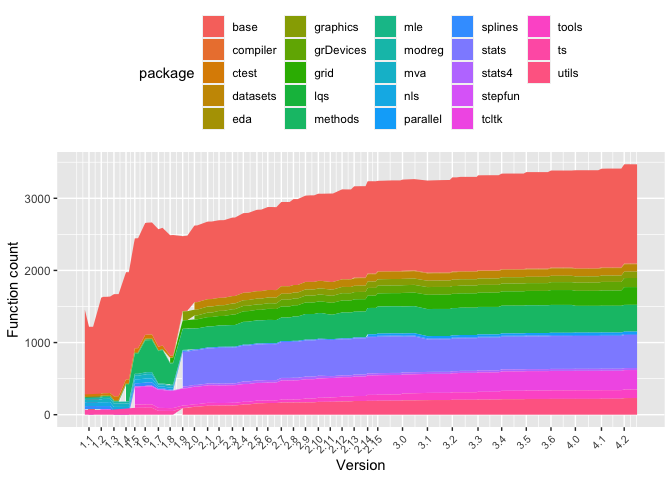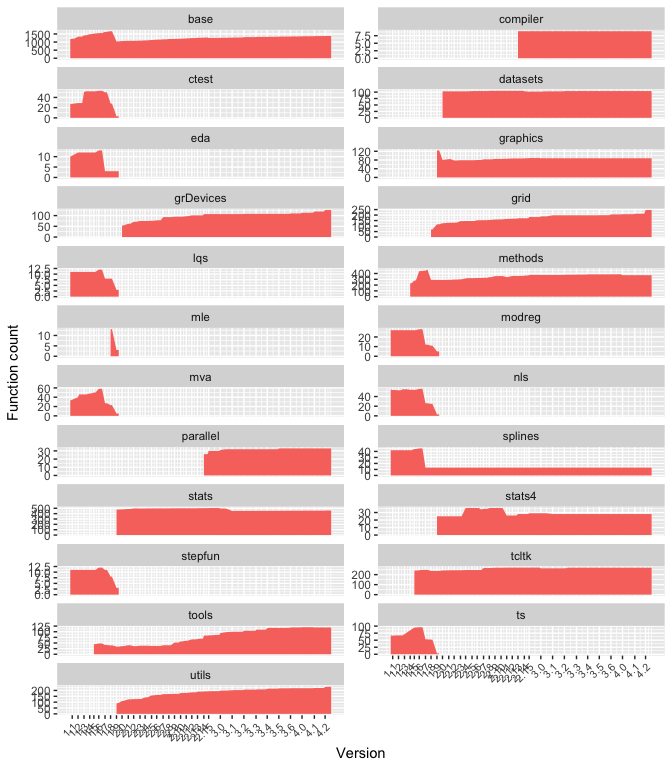A data package which lists every command in base R packages since R version 1.0.1.
The latest R version covered is 4.2.2.
You can view the data online in a Shiny app.
From CRAN:
install.packages('rcheology')Versions 4.2.1 and up are installed from the CRAN apt repositories for Ubuntu Focal.
Versions 4.0.0 to 4.2.0 are installed from the CRAN apt repositories for Ubuntu Bionic.
Versions 3.0.1 to 3.6.3 are installed from the CRAN apt repositories for Ubuntu Trusty Tahr. Version 3.5.0 and up use a special repository.
Versions 2.5.1 to 3.0.0 are built from source on Ubuntu Lucid Lynx.
Versions 1.2.3 to 2.4.1 are mostly built from source on Debian Sarge.
Versions 1.0.1 to 1.2.2 (and a couple of later versions) are built from source on Debian Woody.
Results are found from running ls on all installed
packages from a minimal installation. Recommended packages are not
included.
The Rversions data frame lists versions of R and release
dates.
./control build builds the images. Or get them from https://hub.docker.com/r/dash2/rcheology/../control run runs the images to build/install R and
extract data./control gather gets CSV files from the
containers./control write puts CSV files into a data frame and
stores it in the packagelibrary(rcheology)
data("rcheology")
rcheology[rcheology$name == "kmeans" & rcheology$Rversion %in% c("1.0.1", "1.9.0", "2.1.0", "3.0.2", "3.2.0", "4.0.2"), ]
#> package name Rversion type exported class generic
#> 209705 mva kmeans 1.0.1 closure TRUE <NA> FALSE
#> 229875 stats kmeans 1.9.0 closure TRUE function FALSE
#> 229879 stats kmeans 2.1.0 closure TRUE function FALSE
#> 229918 stats kmeans 3.0.2 closure TRUE function FALSE
#> 229923 stats kmeans 3.2.0 closure TRUE function FALSE
#> 229948 stats kmeans 4.0.2 closure TRUE function FALSE
#> args
#> 209705 (x, centers, iter.max = 10)
#> 229875 (x, centers, iter.max = 10)
#> 229879 (x, centers, iter.max = 10, nstart = 1, algorithm = c("Hartigan-Wong", "Lloyd", "Forgy", "MacQueen"))
#> 229918 (x, centers, iter.max = 10, nstart = 1, algorithm = c("Hartigan-Wong", "Lloyd", "Forgy", "MacQueen"), trace = FALSE)
#> 229923 (x, centers, iter.max = 10L, nstart = 1L, algorithm = c("Hartigan-Wong", "Lloyd", "Forgy", "MacQueen"), trace = FALSE)
#> 229948 (x, centers, iter.max = 10L, nstart = 1L, algorithm = c("Hartigan-Wong", "Lloyd", "Forgy", "MacQueen"), trace = FALSE)Latest changes:
suppressPackageStartupMessages(library(dplyr))
r_penultimate <- sort(package_version(unique(rcheology::rcheology$Rversion)),
decreasing = TRUE)
r_penultimate <- r_penultimate[2]
r_latest_obj <- rcheology %>% dplyr::filter(Rversion == r_latest)
r_penult_obj <- rcheology %>% dplyr::filter(Rversion == r_penultimate)
r_introduced <- anti_join(r_latest_obj, r_penult_obj, by = c("package", "name"))
r_introduced
#> [1] package name Rversion type exported class generic args
#> <0 rows> (or 0-length row.names)Base functions over time:
library(ggplot2)
rvs <- rcheology$Rversion %>%
unique() %>%
as.package_version() %>%
sort() %>%
as.character()
major_rvs <- grep(".0$", rvs, value = TRUE)
major_rv_dates <- Rversions$date[Rversions$Rversion %in% major_rvs]
major_rvs <- gsub("\\.0$", "", major_rvs)
rch_dates <- rcheology %>% left_join(Rversions, by = "Rversion")
ggplot(rch_dates, aes(date, group = package, fill = package), colour = NA) +
stat_count(geom = "area") +
theme(axis.text.x = element_text(angle = 45, hjust = 1, size = 8)) +
# ggthemes::scale_fill_gdocs() +
scale_x_date(breaks = major_rv_dates, labels = major_rvs) +
xlab("Version") + ylab("Function count") +
theme(legend.position = "top")
An alternative view:
ggplot(rch_dates, aes(date, fill = "orange")) +
stat_count(geom = "area") +
scale_x_date(breaks = major_rv_dates, labels = major_rvs) +
theme(axis.text.x = element_text(angle = 45, hjust = 1, size = 8)) +
xlab("Version") + ylab("Function count") +
facet_wrap(~package, scales = "free_y", ncol = 2) +
theme(legend.position = "none") 